22 Search Results for infants
January 14, 2014
by Carole Zangari -
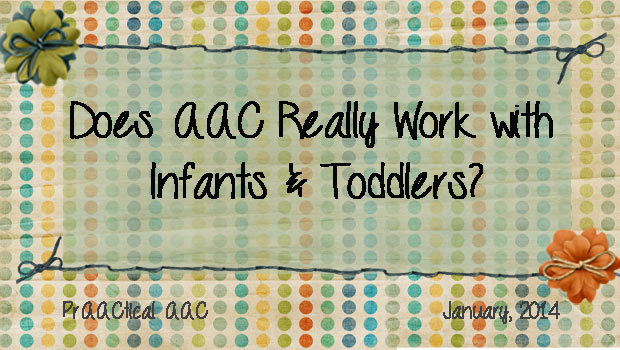
We are occasionally asked how old children have to be before you can begin teaching AAC. Our answer: There is no set minimum age. Nor is there any research evidence that one has to use an oral-language only approach for a set period of time before beginning AAC. Today, we’re delighted to be able to share an article on this topic with you. This article describes a research review in which Branson and Demchak identified a dozen research studies looking specifically at the use of various AAC tools and strategies with infants and toddlers. Data from 190 children up to 36 months of age were examined. Of the 12 studies reviewed, 7 met criteria for having conclusive findings. In 97% of all cases, the children’s communication skills improved. Looking only at the 7 most rigorous studies is even more encouraging: All 135 babies/toddlers demonstrated improved communication skills following AAC intervention.... [Read More...]
January 12, 2025
by Carole Zangari -
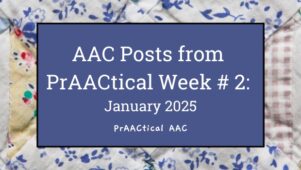
Happy Sunday, AAC friends. I hope you had a good week and are ready for a little touch of AAC. Monday – Sun, Rain, Sleet, or Snow: AAC Conversations About the Weather Tuesday – AAC Link Up Wednesday – Video of the Week: A Quick Look at Alternative Access for AAC Thursday – AAC-friendly Ideas for Honoring Martin Luther King, Jr Day :::::::::::::::::::::::::::::::::::::::::::::::::::::::::::::::::::::::::::::::::::::::::::::::::::::::::::::::::::::::::::::::::::::::::::::::::::::::::: Ready for a few more posts to browse? Here’s a sampling that you might enjoy. Does AAC Really Work with Infants and Toddlers? Research Tuesday: Photos Versus PCS – Babies Weigh In AAC & AT Supports in Early Intervention AAC Mythology v2.0: A Few Misconceptions About AAC Intervention A District-wide Core Vocabulary Initiative
September 11, 2023
by Carole Zangari -
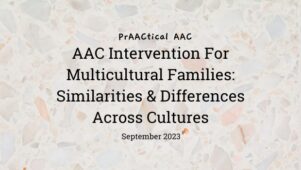
Across the world, AAC teams are looking for ways to strengthen their support of multilingual individuals with complex communication needs. In this article, guest authors Hsiao-Ting Su and Wen-Hsin Ku, who are both bilingual Mandarin-English SLPs, share their thoughts. AAC Intervention for Multicultural Families – Similarities and Differences Across Cultures Though there are limited AAC resources in minority languages at this time, SLPs should make every effort to meet the needs of multicultural families. It is crucial for SLPs to keep cultural differences in mind when working with multicultural families. As two bilingual English-Mandarin-speaking SLPs who have worked with both families in the U.S. and Taiwan, we have first-hand experience navigating similarities and differences across cultures. Here, we describe some of the similarities and differences we have encountered most frequently. Similarities: Families worry that AAC will hinder verbal communication development Families need reassurance that it is okay for children to... [Read More...]
April 10, 2023
by Carole Zangari -
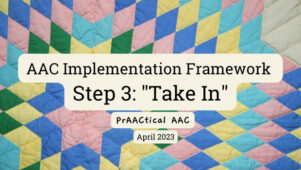
Welcome to the next installment of Vicki Clarke’s AAC Implementation Framework. In today’s post, Vicki focuses on the role of the communication partner, with prAACtical ideas for helping them utilize key support strategies that facilitate AAC learning. New to this series? You find the earlier posts using the links below. Steps to Learning Step 1, Determining the Target Step 2: TRAIN ::::::::::::::::::::::::::::::::::::::::::::::::::::::::::::::::::::::::::::::::::::::::::: AAC Implementation Framework Step 3: “Take In” In our journey towards teaching autonomous communication, Step 3: “Take In” is dedicated to the partner’s role, which involves modeling the use of AAC to communicate words and messages in real-world situations. The aim of this stage is to help the student learn when and how to communicate using AAC, as well as to develop a clear understanding of the practical application of these skills by watching their partner’s interactions. This process mirrors the way in which infants and toddlers acquire... [Read More...]
April 7, 2023
by Carole Zangari -
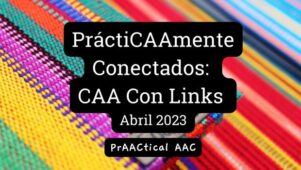
Each month we feature a Spanish version of our AAC Link Up, CAA con Links. If you have AAC-related announcements, materials, or videos in Spanish that you would like others to know about, we’d love to have you add that information below. Also, please share this with anyone who might be interested in contributing to or using the materials that get added to these posts. You’ll find the place to add that information at the very bottom of this post. Organized by Claudia Marimón, these monthly posts also feature AAC work being done in Spanish-speaking countries and offer translations of material that can help families and service providers. Today, she partners with Rita María Aceituno in focusing on the AAC support provided to Guatemalan children with Down Syndrome by Fundación Margarita Tejada. Enjoy the post, and remember to scroll to the bottom to add your link and see what others... [Read More...]
January 9, 2023
by Carole Zangari -
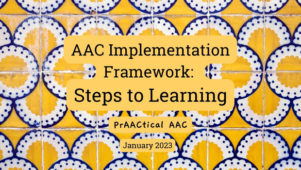
We’re so pleased to welcome PrAACtical AAC contributor Vicki Clarke back to these pages. While you may remember Vicki from her outstanding AAC Assessment Corner posts, her most recent efforts focus on strengthening our AAC practices. Throughout the series, Vicki draws on her experiences supporting AAC users and teams in clinical and school settings and shares prAACtical information that we can all learn from Introduction to AAC 101 Steps to Learning It is no small task to consider how we will help our students progress from communicating only through behaviors to communicating any message they desire independently and spontaneously. In fact, in 1997, Gloria Soto conducted survey research that tells us: Teachers have always believed that communication training for students is positive, and Communication training is a collaborative effort between teachers and SLPs, Despite these beliefs, there is still a prevalent hesitancy to begin to explicitly instruct students in AAC.... [Read More...]
January 8, 2023
by Carole Zangari -
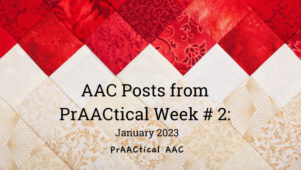
Happy Sunday, AAC friends. This is a great day for catching up on some AAC reading. Monday – 2023: A PrAACtical New Year Tuesday – AAC Link Up Wednesday – Video of the Week: Incorporating Comprehensive Literacy Instruction into AAC Intervention Thursday – Growing AAC Professionals: A Guide to Voice Banking Friday – CAA Con Links – Enero 2023 :::::::::::::::::::::::::::::::::::::::::::::::::::::::::::::::::::::::::::::::::::::::::::::::::::::::::::::::::::::::::::::::::::::::::::::::::::::::::: Ready for a few more posts to browse? Here’s a sampling that you might enjoy. Does AAC Really Work with Infants and Toddlers? Research Tuesday: Photos Versus PCS – Babies Weigh In AAC & AT Supports in Early Intervention AAC Mythology v2.0: A Few Misconceptions About AAC Intervention A District-wide Core Vocabulary Initiative
April 19, 2021
by Carole Zangari -
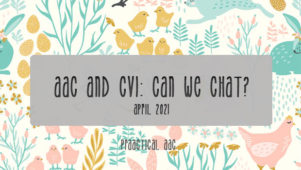
Do you serve students with cortical visual impairment (CVI)? Teacher of the visually impaired Dr. Sandra Newcomb and AAC SLP Debbie Perry regularly combine their expertise and collaborate to support children with CVI who are learning to use AAC. In today’s post, they take us beyond the basics to share their thoughts on the complex issues that we should consider in serving this population. Follow along as they challenge some assumptions and provide helpful suggestions. :::::::::::::::::::::::::::::::::::::::::::::::::::::::::::::::::::::::::::::::::::::::: AAC and CVI: Can We Chat? Cortical Visual Impairment (CVI) is vision loss due to damage or malformation in the brain that interferes with the child’s ability to understand vision information coming from the eyes. It is the number one cause of vision impairment for young children in developed countries. It has been found that 10.5% of children with developmental disabilities have CVI [1]. This means if you are a pediatric SLP you will... [Read More...]
January 10, 2021
by Carole Zangari -
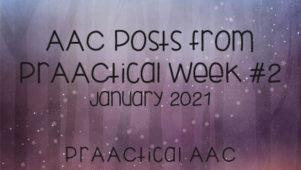
Happy Sunday, AAC friends. We have some posts that may be of interest. Monday – AAC in Secondary School: Research Project AACtivity Tuesday – AAC Link Up Wednesday – Video of the Week: A District-wide Core Vocabulary Initiative Thursday – Throwback Thursday: Considerations in AAC Intervention Friday – PráctiCAAmente Conectados Con Links – Enero 2021 :::::::::::::::::::::::::::::::::::::::::::::::::::::::::::::::::::::::::::::::::::::::::::::::::::::::::::::::::::::::::::::::::::::::::::::::::::::::::: Ready for a few more posts to browse? Here’s a sampling that you might enjoy. Does AAC Really Work with Infants and Toddlers? Research Tuesday: Photos Versus PCS – Babies Weigh In AAC & AT Supports in Early Intervention AAC Mythology v2.0: A Few Misconceptions About AAC Intervention PrAACtical Intervention Ideas: AAC Learning with the Toys, Websites, and Apps You Love
April 9, 2020
by Carole Zangari -
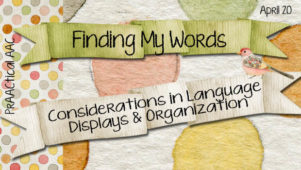
How do you decide which AAC app or software best meets the needs of an individual with complex communication needs? We’re so pleased that longtime contributor Vicki Clarke is back with us to address this topic in a very prAACtical way. Vicki is a Georgia-based SLP who has been specializing in AAC for over 25 years. Her practice, Dynamic Therapy Associates, serves children and adults with significant communication challenges in clinical and educational settings. You can read previous posts by Vicki here. In this post, Vicki dives deep into an important aspect of AAC displays: vocabulary organization. :::::::::::::::::::::::::::::::::::::::::::::::::::::::::::::::::: Finding My Words: Considerations in Language Displays and Organization In previous articles we’ve talked about how easy it is to buy into the very first communication system you learn to use with your students. Maybe you started with LAMP and you have fully embraced a core word strategy. Perhaps you were a... [Read More...]









